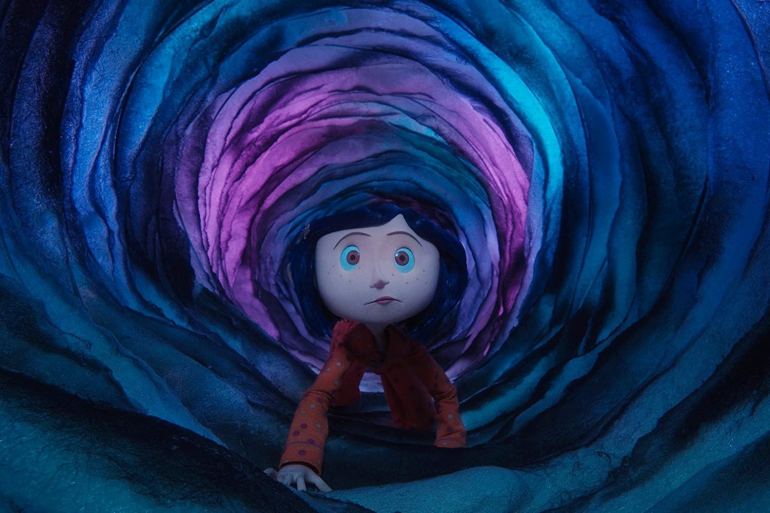Henry Selick added an entirely new meaning and a fresh coat of fear to the horror genre back in 2009 with Coraline. From the moment I watched the very first trailer for this film, I knew it was going to be something beyond special, and something extremely different. Coraline terrified children and adults all over the world, becoming a revolutionary, unconventional and very scary children’s ‘horror’ film.
Coraline is the story of a girl of the same name (voiced by Dakota Fanning) who moves with her parents Mr. & Mrs. Jones (John Hodgman and Teri Hatcher, respectively) to the “Pink Palace,” an extravagant house in the middle of a bland neighborhood. Coraline doesn’t like her new life and wishes to be anywhere but there. One day, she finds a door that leads her to another world where everything, even her parents, are better—a dream world. However, Coraline will soon realize that nothing is what it seems and that you have to be careful what you wish for.
I remember the feeling my sister and I had after first watching Coraline. Being 6 years apart, she was obviously more scared than I was, and watching it myself I didn’t really feel fear—I felt inspiration like this film was made just for me. Like any other child, I had always been scared of horror films growing up, but Coraline danced perfectly along the thin line of children’s horror and fantasy. The “Other World” that Coraline discovers is basically a mirrored reality, where she finds a sinister and manipulative version of her mom: her Other Mother, who has an evil plan to sew buttons to Coraline’s eyes and devour her soul—taking her into the Other World forever.
Selick’s popular and critically-acclaimed predecessors, James and the Giant Peach and The Nightmare Before Christmas, proved that he was no stranger to the world of stop-motion and claymation. The attention to detail and the amount of time and effort put into Coraline is extraordinary—especially when given that, at the height of production, they were only able to complete 90-100 seconds of completed animation per week. Every single object you see on screen throughout the film was specifically created for its scene, using the help of 3D printing to develop each piece perfectly. One crew member, Althea Crome, was specifically brought on to knit mini clothing for the animated characters—sometimes even using needles as thin as a strand of hair.
Selick’s main goal with Coraline was to, as he has said, “go there” with it. He didn’t want to shy away from or hinder the dark subject matter within Gaiman’s novel. Categorizing this film under “children’s horror” seems rather silly to me, but I want to describe Coraline for what it truly is and for what the team behind it wanted it to be.
Selick creates something within this beloved classic that is hard to adapt. By creating his own original view and feel, he uses the freedom of animation and imagination to switch his characters into skeletal and spooky doppelgängers preying over poor little Coraline. The director is as progressive and creative in his imagery and setting as Gaiman is in his original writing. The atmosphere of this film could perhaps remind adult audiences of the filmography of talented artists such as Guillermo del Toro and Tim Burton—the latter of whom has absolutely nothing to do with Coraline, much to my surprise a few years ago.
Taking on the job of adapting a beloved novel is undoubtedly nerve-wracking, but I can imagine that, for the author of that beloved novel, the process is even more stressful. The original author of Coraline, Neil Gaiman, was mostly satisfied with Selick’s final product of the film, except for the ending—which he hated. Gaiman told Entertainment Weekly that he didn’t exactly care for a moment in the finale: “I was uncomfortable with feeling like Wybie had rescued her at the end,” he said. “She has to rescue herself.”
Coraline is often ignored and pushed away as her parents work from home. Her Other parents are focused on meeting her every need, but they don’t love her and know her like her real parents do, and Coraline eventually learns to appreciate her actual reality for what it is. The emotion that was transmitted through Coraline to the audience at the beginning is loneliness. A quirky and sassy girl, who had recently moved from Michigan to an apartment in a big pink Victorian house in Oregon, is rightfully feeling like she doesn’t belong where she and her parents have ended up. Gaiman allows the two universes to influence and feed off of each other, and Selick is so attentive in making this work. The audience watches in awe as Coraline’s emotionally draining home is brought to life by an equally draining and not-so-enchanting enchantment. Nothing in her life feels or looks right, so it’s no surprise that she ventures off by herself to find something worth living for.
The ideal audience for this film would be, well, children. Going back and looking at this piece of art in retrospect, I can see that Selick targeted a range of demographics. One of these possible audiences is the cinephiles, who get riled up when they see something different or unconventional in a film that they’ve never seen before.
Now I’m watching Coraline 10 years later—no longer being that eleven-year-old girl who was terrified, slouching in her seat at her hometown cinema. Coraline was revolutionary. It is artistic, disturbing, completely refreshing for the horror genre, and it will be remembered and cherished for years to come. Perfection is just an illusion and, sometimes, the grass truly isn’t greener on the other side of reality.
Coraline is now available for streaming via Netflix
To help us continue to create content, please consider supporting us on Patreon: https://www.patreon.com/filmera.


